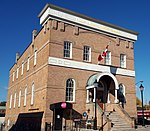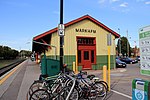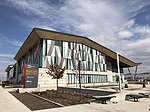Vinegar Hill, Ontario
Vinegar Hill (also Vinegar Hill Dip) is an unincorporated community in Markham, Ontario, Canada bounded by Highway 7 to the north, Highway 407 to the south, and streets just west and east of Main Street South, bordered by the Rouge River. The name of the community is believed to be linked to a cider mill on the east side of the river valley or barrel makers that filled them with vinegar to test their straightness when rolling down Markham Road.The community is located just south of the historic village of Markham, and has several historic homes reflecting its rich history of being one of the first neighbourhoods settled in Markham. With walking paths along the Rouge River, its abundant wildlife and flora, its proximity to 407, and walking distance to Historic Main Street, this small neighbourhood has many amenities. The Main Street Markham South Bridge was a small concrete beam girder bridge with 2 lanes of traffic traversed over the Rouge River and connected Vinegar Hill to the Historic Village of Markham (this 1946 bridge replaced three bridges (including one washed out during Hurricane Hazel in 1954) that crossed the Rouge on Princess Street, Mill Street and Markham Road). The bridge was repaired in 1980-1981. In 2014 the old Main Street Markham Bridge was demolished and replaced with a new three lane box girder bridge and will be completed by end of 2015.
Excerpt from the Wikipedia article Vinegar Hill, Ontario (License: CC BY-SA 3.0, Authors).Vinegar Hill, Ontario
Rouge Street, Markham
Geographical coordinates (GPS) Address Nearby Places Show on map
Geographical coordinates (GPS)
| Latitude | Longitude |
|---|---|
| N 43.867777777778 ° | E -79.256666666667 ° |
Address
Rouge Street 16
L3P 1K7 Markham
Ontario, Canada
Open on Google Maps






